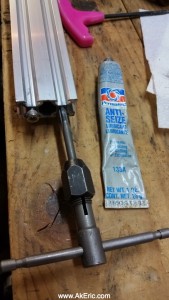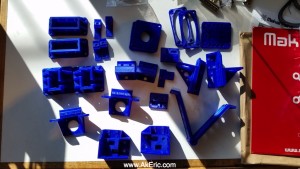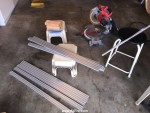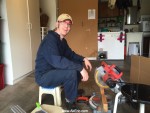Jump to C-Bot blog index to see all the posts.
For this build, based on the recommendation of Mason, I picked up a Corsair CX 500 PC power supply from newegg. 500 watts of power, can do 38A at 12v (with a single dedicated 12v rail), so should be more than enough power for now, but room to grow.
Simple current calculations based on the biggest offenders:
- 6x nema 17 steppers @ 1.68A (max) = 10.08A :
- Core-XY mechanics, x2. Z-stage. x2, Extruder, x1 (+ 1 extra for dual-strusion later…)
- 12×12″ heated build plate : 20A
- + other smaller draws.
After I got it he mentioned: “Oh yah, you’ll need to modify that too”. Uh, what? 
He pointed me to this great vid by MakerGeeks (I also like their (US made) filament), which shows you how to do the whole operation.
Highlights are:
- Ground the green wire to trick the system into thinking there’s always a load. Otherwise it won’t want to turn on…
- Strip and plug the 12v wires/ground into your mainboard.
But this power supply has many bundles wires pouring out the side, far more than I’ll need. I also knew this supply supported three different voltages, so after I hack-grounded the green wire using a paper-clip, I used my multimeter to check different colored wires:
- Yellow : 12.46v
- Red : 5.01v
- Orange: 3.36v
Telling me, cut everything but yellow (and black).
So I got to work: Opening the case, I isolated the green wire, and soldered it to one of the grounds. Heat-shrinked the result, tucked out of the way.
I need two separate lines of power out of the box: One for the Rumba, and one for the HBP. There were three bundles running out of the machine with yellow & black wires only: Removing them from their protective mesh sleeving, I collected/connected (via twist & solder) three yellow/black for my HBP power, and another two yellow/black for the Rumba board power (could probably get away with one, I’m just playing it safe): While the Rumba can power a HBP, it’s rated at 11A. Since my monster 12×12″ HBP can draw up to 20A when heating, I need to connect it directly to the power supply (it’s temp will be controlled via a relay). I choose to use three wires to visually match the gauge of the wires pre-soldered to the HBP.
Finally, everything else got chopped to about 3″ off the mainboard (in case for some reason I need to use them in the future). I wrapped each end in electrical tape, wrapped the whole bundle in electrical tape, then clamped it down with zip-ties so nothing will come undone if things get hot.
I was very happy than upon reassemble it worked 😉 Next steps would be hooking it to the Rumba (which hasn’t arrived yet) and the heated bed.
-

-
Spaghett!
-

-
Trimmed up
-

-
Cleaned up
Jump to C-Bot blog index to see all the posts.










